Презентация Week 1-2 The tourism System AGB 2003
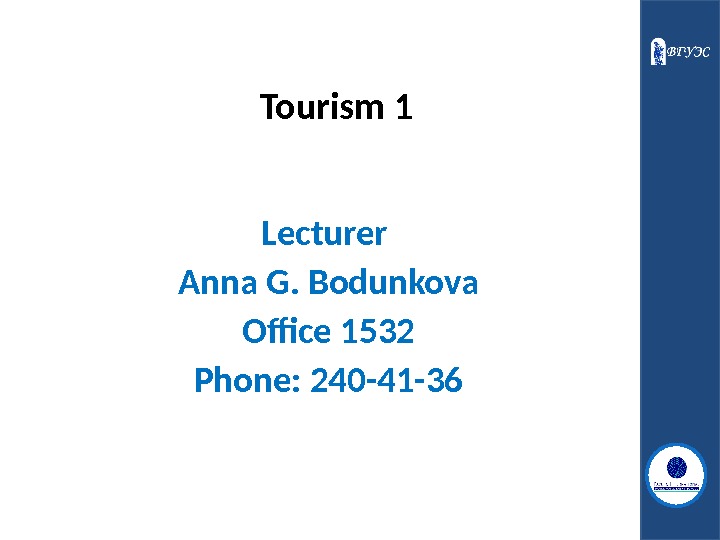
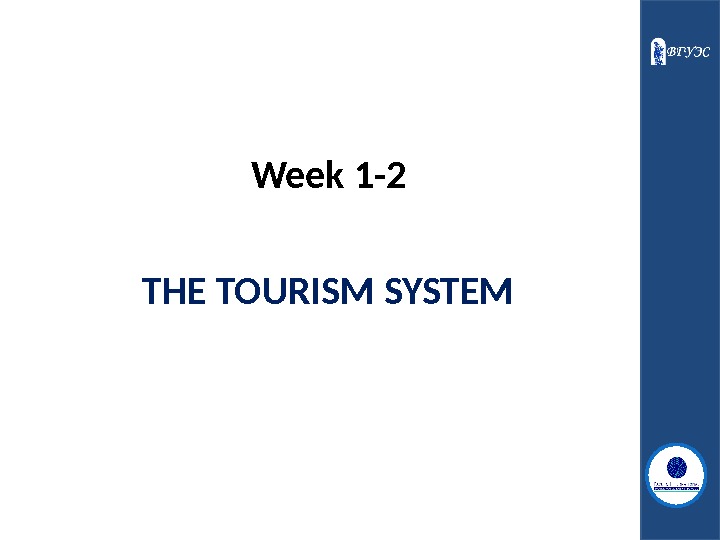
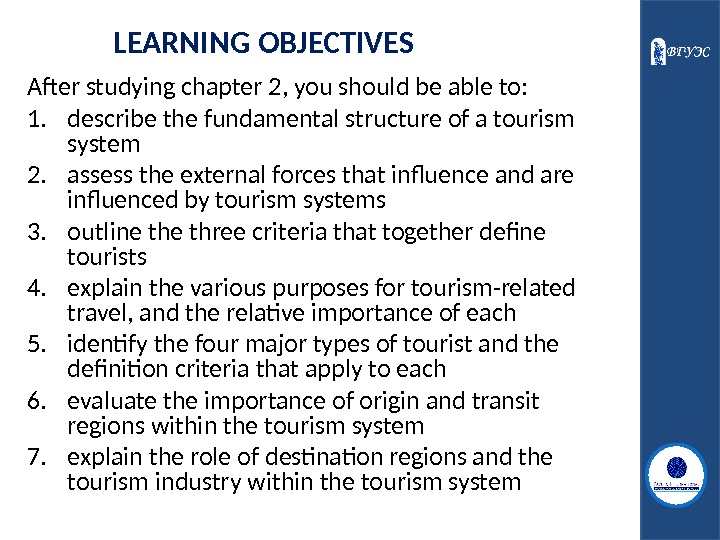


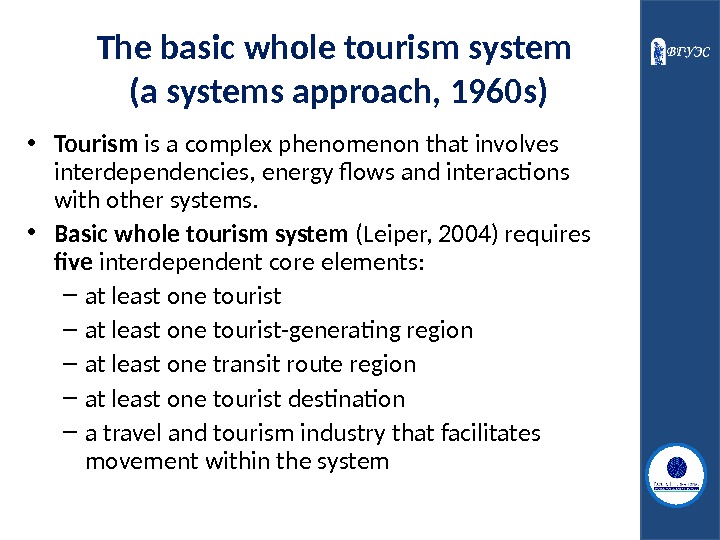
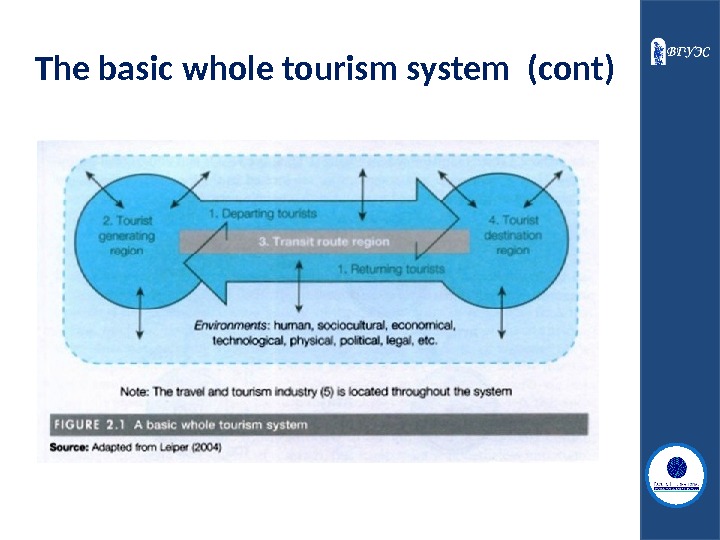
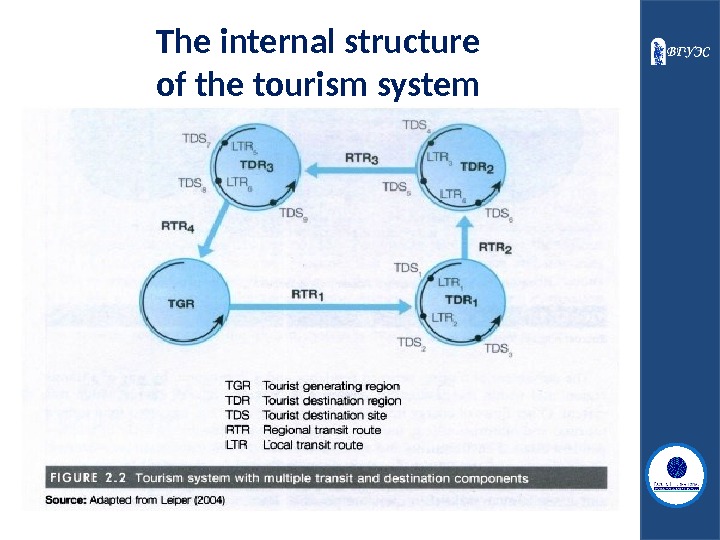
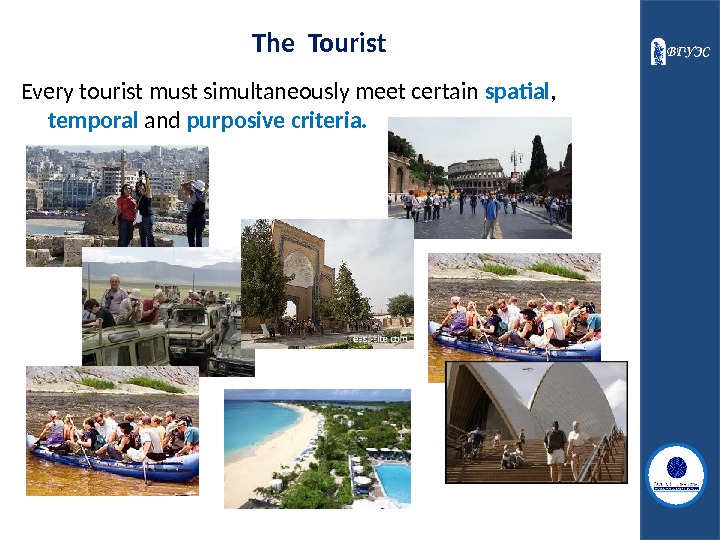
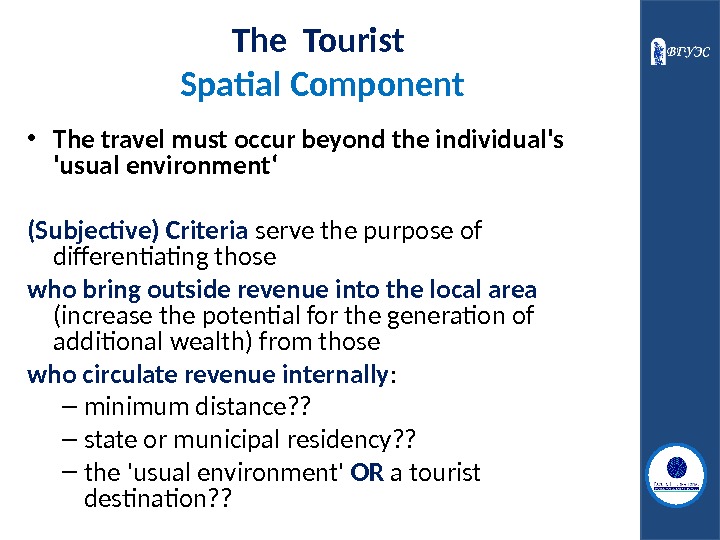
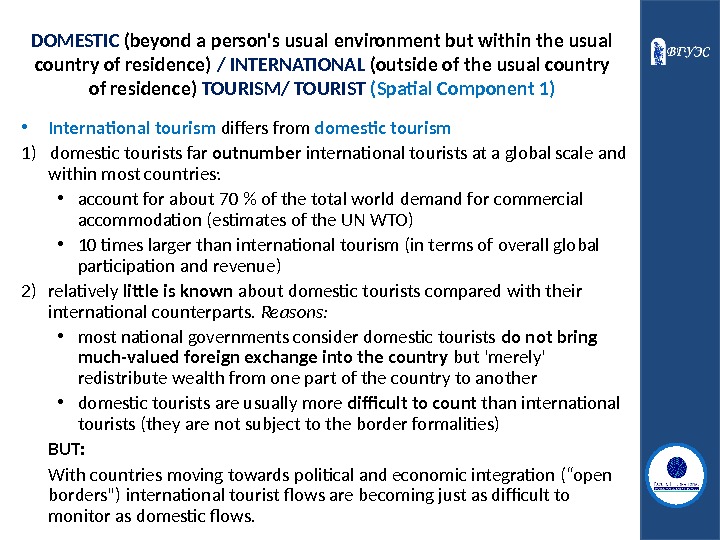
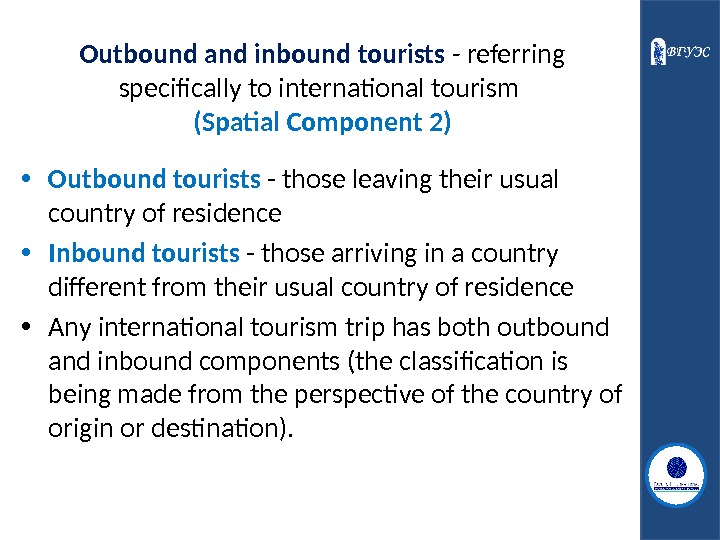
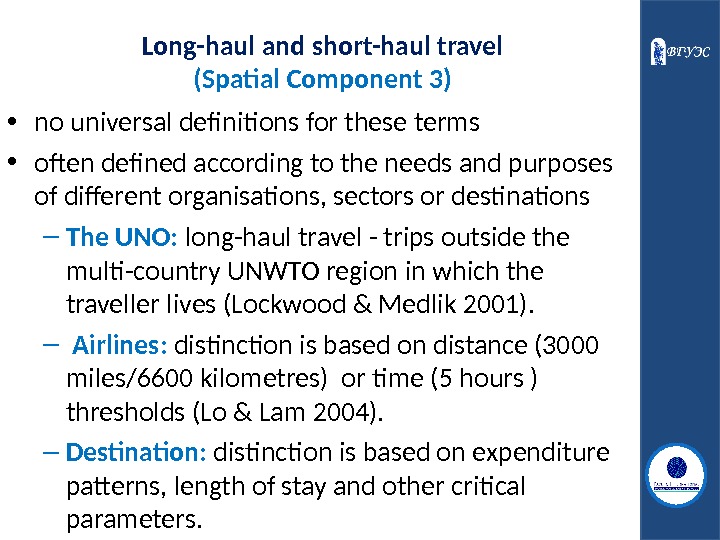

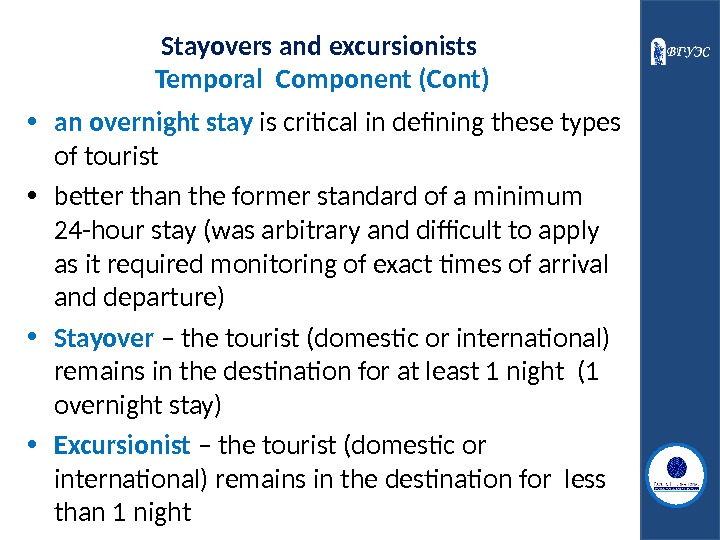
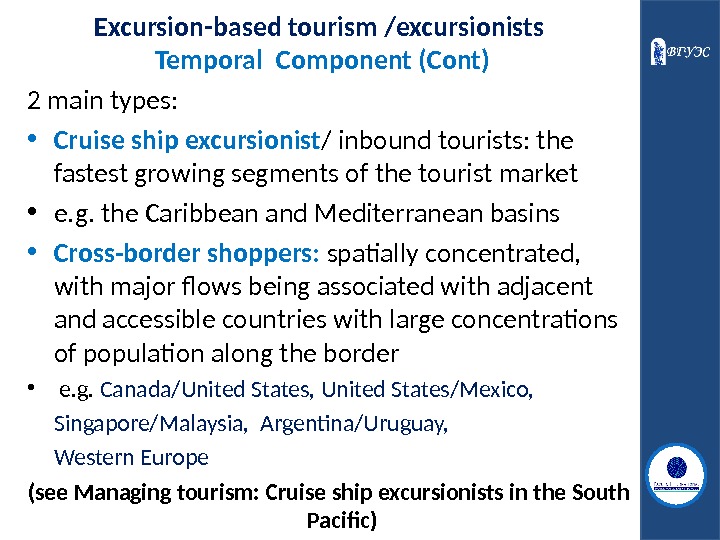
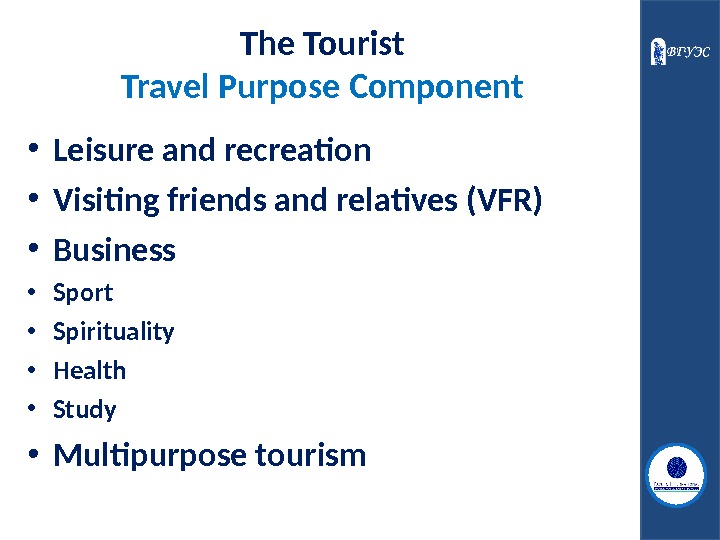
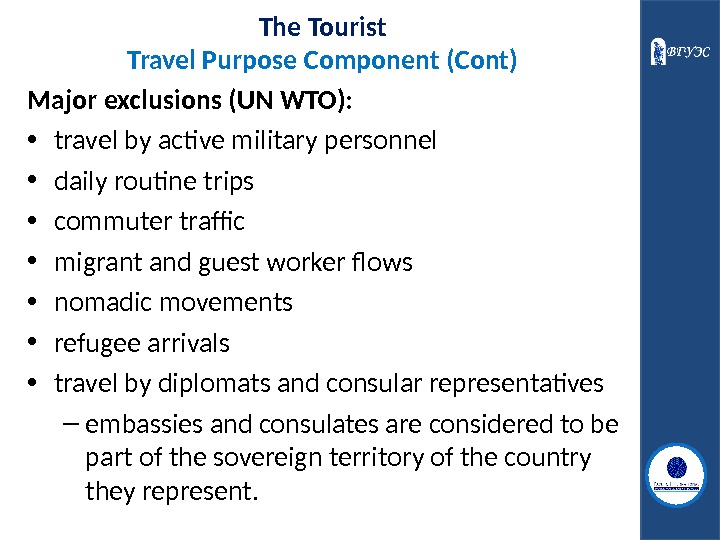
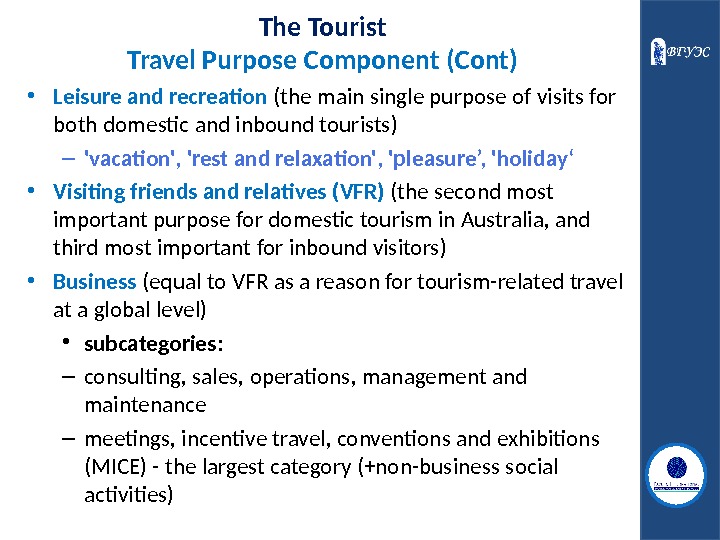


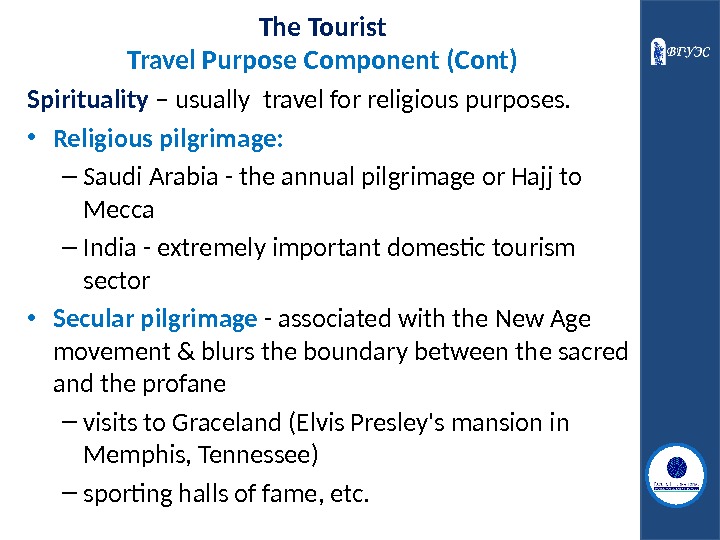
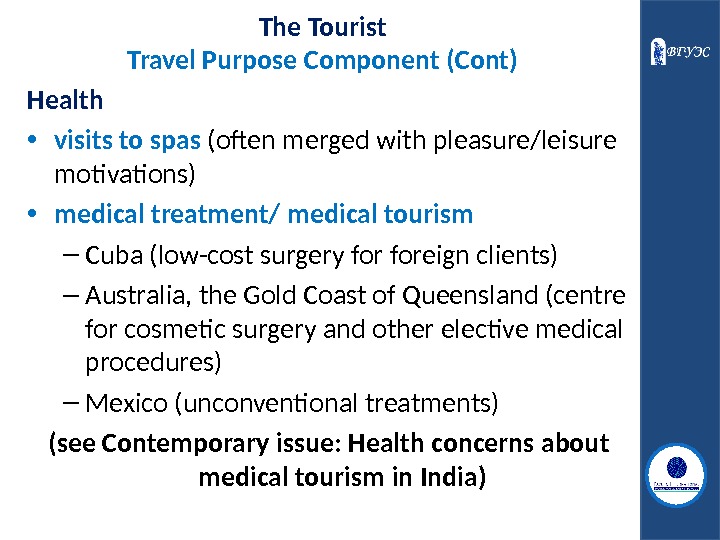
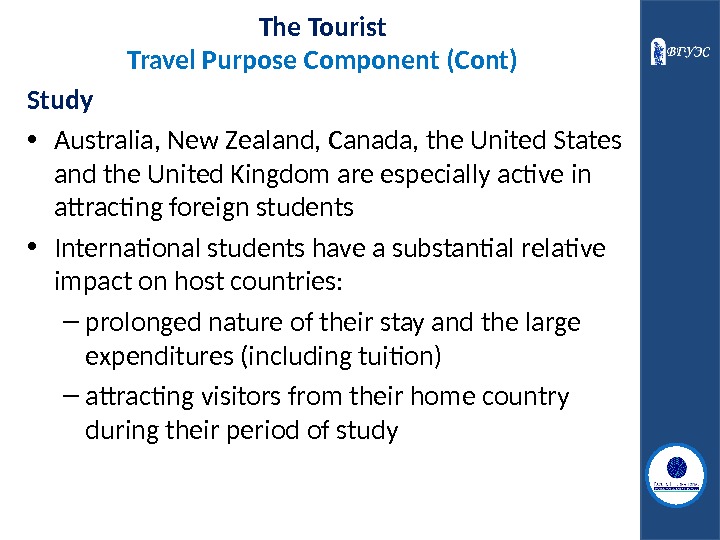
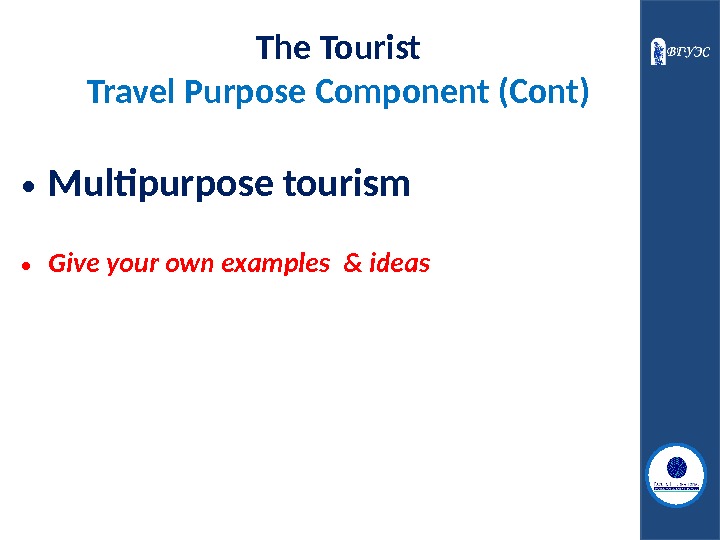
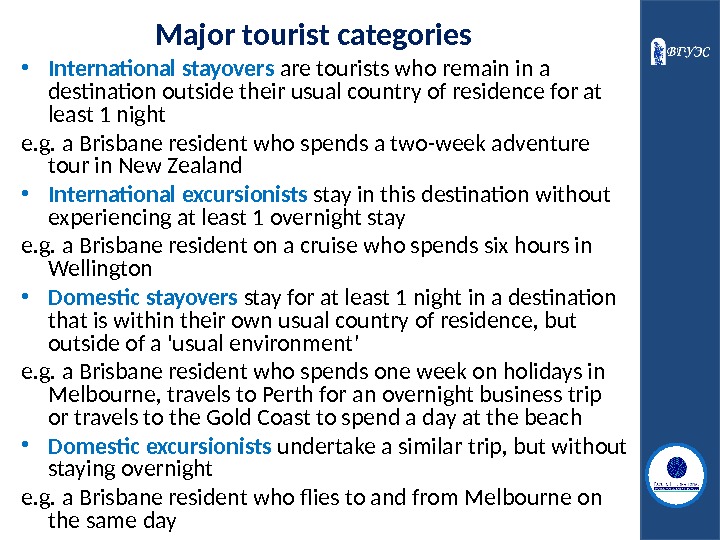
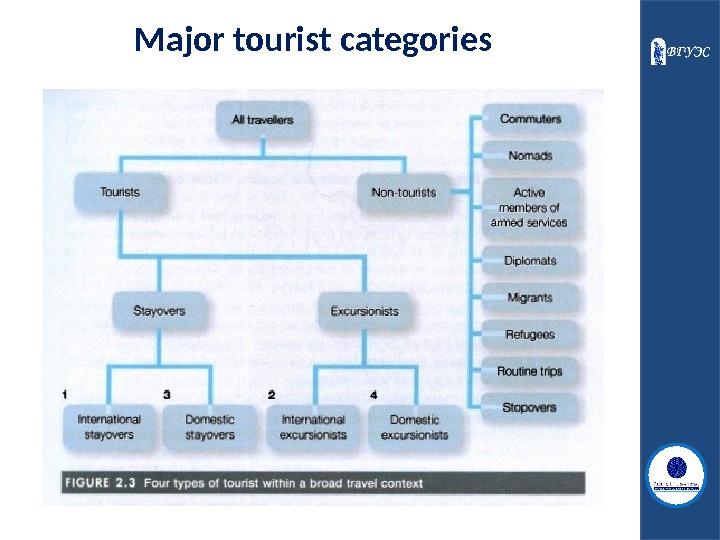

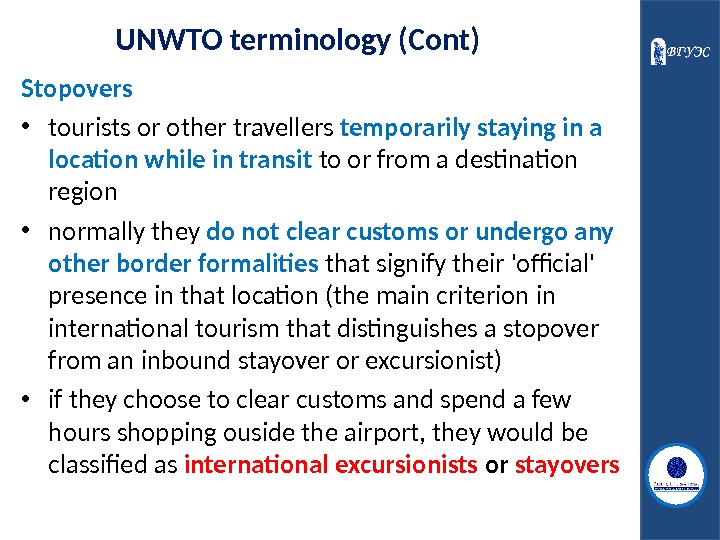
- Размер: 4.4 Mегабайта
- Количество слайдов: 29
Описание презентации Презентация Week 1-2 The tourism System AGB 2003 по слайдам
 Tourism 1 Lecturer Anna G. Bodunkova Office 1532 Phone: 240 -41 —
Tourism 1 Lecturer Anna G. Bodunkova Office 1532 Phone: 240 -41 —
 Week 1 -2 THE TOURISM SYSTEM
Week 1 -2 THE TOURISM SYSTEM
 LEARNING OBJECTIVES After studying chapter 2 , you should be able to: 1. describe the fundamental structure of a tourism system 2. assess the external forces that influence and are influenced by tourism systems 3. outline three criteria that together define tourists 4. explain the various purposes for tourism-related travel, and the relative importance of each 5. identify the four major types of tourist and the definition criteria that apply to each 6. evaluate the importance of origin and transit regions within the tourism system 7. explain the role of destination regions and the tourism industry within the tourism system
LEARNING OBJECTIVES After studying chapter 2 , you should be able to: 1. describe the fundamental structure of a tourism system 2. assess the external forces that influence and are influenced by tourism systems 3. outline three criteria that together define tourists 4. explain the various purposes for tourism-related travel, and the relative importance of each 5. identify the four major types of tourist and the definition criteria that apply to each 6. evaluate the importance of origin and transit regions within the tourism system 7. explain the role of destination regions and the tourism industry within the tourism system
 A System Approach to Tourism A system is a group of interrelated, interdependent and interacting elements that together form a single functional structure. Systems theory emerged in the 1930 s to clarify and organise complex phenomena that are too difficult to describe or analyse (Leiper 2004). Systems always involve interaction with external systems. A change in a system component will affect other components of that system ( interdependence!!! )
A System Approach to Tourism A system is a group of interrelated, interdependent and interacting elements that together form a single functional structure. Systems theory emerged in the 1930 s to clarify and organise complex phenomena that are too difficult to describe or analyse (Leiper 2004). Systems always involve interaction with external systems. A change in a system component will affect other components of that system ( interdependence!!! )
 A System Approach to Tourism Systems tend to be hierarchical: they consist of subsystems and are themselves part of larger structures: e. g. a human body comprises digestive, reproductive and other subsystems, e. g. human beings are members of broader social systems (families, clans, nations).
A System Approach to Tourism Systems tend to be hierarchical: they consist of subsystems and are themselves part of larger structures: e. g. a human body comprises digestive, reproductive and other subsystems, e. g. human beings are members of broader social systems (families, clans, nations).
 The basic whole tourism system (a systems approach, 1960 s) • Tourism is a complex phenomenon that involves interdependencies, energy flows and interactions with other systems. • Basic whole tourism system (Leiper, 2004) requires five interdependent core elements: – at least one tourist-generating region – at least one transit route region – at least one tourist destination – a travel and tourism industry that facilitates movement within the system
The basic whole tourism system (a systems approach, 1960 s) • Tourism is a complex phenomenon that involves interdependencies, energy flows and interactions with other systems. • Basic whole tourism system (Leiper, 2004) requires five interdependent core elements: – at least one tourist-generating region – at least one transit route region – at least one tourist destination – a travel and tourism industry that facilitates movement within the system
 The basic whole tourism system (cont)
The basic whole tourism system (cont)
 The internal structure of the tourism system
The internal structure of the tourism system
 The Tourist Every tourist must simultaneously meet certain spatial , temporal and purposive criteria.
The Tourist Every tourist must simultaneously meet certain spatial , temporal and purposive criteria.
 The Tourist Spatial Component • The travel must occur beyond the individual’s ‘usual environment‘ (Subjective) Criteria serve the purpose of differentiating those who bring outside revenue into the local area (increase the potential for the generation of additional wealth) from those who circulate revenue internally : – minimum distance? ? – state or municipal residency? ? – the ‘usual environment’ OR a tourist destination? ?
The Tourist Spatial Component • The travel must occur beyond the individual’s ‘usual environment‘ (Subjective) Criteria serve the purpose of differentiating those who bring outside revenue into the local area (increase the potential for the generation of additional wealth) from those who circulate revenue internally : – minimum distance? ? – state or municipal residency? ? – the ‘usual environment’ OR a tourist destination? ?
 DOMESTIC (beyond a person’s usual environment but within the usual country of residence) / INTERNATIONAL (outside of the usual country of residence) TOURISM/ TOURIST (Spatial Component 1) • International tourism differs from domestic tourism 1) domestic tourists far outnumber international tourists at a global scale and within most countries: • account for about 70 % of the total world demand for commercial accommodation (estimates of the UN WTO) • 10 times larger than international tourism (in terms of overall global participation and revenue) 2) relatively little is known about domestic tourists compared with their international counterparts. Reasons: • most national governments consider domestic tourists do not bring much-valued foreign exchange into the country but ‘merely’ redistribute wealth from one part of the country to another • domestic tourists are usually more difficult to count than international tourists (they are not subject to the border formalities) BUT: With countries moving towards political and economic integration (“open borders”) international tourist flows are becoming just as difficult to monitor as domestic flows.
DOMESTIC (beyond a person’s usual environment but within the usual country of residence) / INTERNATIONAL (outside of the usual country of residence) TOURISM/ TOURIST (Spatial Component 1) • International tourism differs from domestic tourism 1) domestic tourists far outnumber international tourists at a global scale and within most countries: • account for about 70 % of the total world demand for commercial accommodation (estimates of the UN WTO) • 10 times larger than international tourism (in terms of overall global participation and revenue) 2) relatively little is known about domestic tourists compared with their international counterparts. Reasons: • most national governments consider domestic tourists do not bring much-valued foreign exchange into the country but ‘merely’ redistribute wealth from one part of the country to another • domestic tourists are usually more difficult to count than international tourists (they are not subject to the border formalities) BUT: With countries moving towards political and economic integration (“open borders”) international tourist flows are becoming just as difficult to monitor as domestic flows.
 Outbound and inbound tourists — referring specifically to international tourism (Spatial Component 2) • Outbound tourists — those leaving their usual country of residence • Inbound tourists — those arriving in a country different from their usual country of residence • Any international tourism trip has both outbound and inbound components (the classification is being made from the perspective of the country of origin or destination).
Outbound and inbound tourists — referring specifically to international tourism (Spatial Component 2) • Outbound tourists — those leaving their usual country of residence • Inbound tourists — those arriving in a country different from their usual country of residence • Any international tourism trip has both outbound and inbound components (the classification is being made from the perspective of the country of origin or destination).
 Long-haul and short-haul travel (Spatial Component 3) • no universal definitions for these terms • often defined according to the needs and purposes of different organisations, sectors or destinations – The UNO: long-haul travel — trips outside the multi-country UNWTO region in which the traveller lives (Lockwood & Medlik 2001). – Airlines: distinction is based on distance (3000 miles/6600 kilometres) or time (5 hours ) thresholds (Lo & Lam 2004). – Destination: distinction is based on expenditure patterns, length of stay and other critical parameters.
Long-haul and short-haul travel (Spatial Component 3) • no universal definitions for these terms • often defined according to the needs and purposes of different organisations, sectors or destinations – The UNO: long-haul travel — trips outside the multi-country UNWTO region in which the traveller lives (Lockwood & Medlik 2001). – Airlines: distinction is based on distance (3000 miles/6600 kilometres) or time (5 hours ) thresholds (Lo & Lam 2004). – Destination: distinction is based on expenditure patterns, length of stay and other critical parameters.
 The Tourist Temporal Component Criteria: • domestic tourist — at least a few hours trip • inbound (international) tourist – maximum 1 year to remain in the visited country (UNWTO) • once upper thresholds are exceeded, the visitor should be reassigned to a more appropriate category — such as ‘temporary resident’ or ‘migrant’
The Tourist Temporal Component Criteria: • domestic tourist — at least a few hours trip • inbound (international) tourist – maximum 1 year to remain in the visited country (UNWTO) • once upper thresholds are exceeded, the visitor should be reassigned to a more appropriate category — such as ‘temporary resident’ or ‘migrant’
 Stayovers and excursionists Temporal Component (Cont) • an overnight stay is critical in defining these types of tourist • better than the former standard of a minimum 24 -hour stay (was arbitrary and difficult to apply as it required monitoring of exact times of arrival and departure) • Stayover – the tourist (domestic or international) remains in the destination for at least 1 night (1 overnight stay) • Excursionist – the tourist (domestic or international) remains in the destination for less than 1 night
Stayovers and excursionists Temporal Component (Cont) • an overnight stay is critical in defining these types of tourist • better than the former standard of a minimum 24 -hour stay (was arbitrary and difficult to apply as it required monitoring of exact times of arrival and departure) • Stayover – the tourist (domestic or international) remains in the destination for at least 1 night (1 overnight stay) • Excursionist – the tourist (domestic or international) remains in the destination for less than 1 night
 Excursion-based tourism /excursionists Temporal Component (Cont) 2 main types: • Cruise ship excursionist / inbound tourists: the fastest growing segments of the tourist market • e. g. the Caribbean and Mediterranean basins • Cross-border shoppers: spatially concentrated, with major flows being associated with adjacent and accessible countries with large concentrations of population along the border • e. g. Canada/United States, United States/Mexico, Singapore/Malaysia, Argentina/Uruguay, Western Europe (see Managing tourism: Cruise ship excursionists in the South Pacific)
Excursion-based tourism /excursionists Temporal Component (Cont) 2 main types: • Cruise ship excursionist / inbound tourists: the fastest growing segments of the tourist market • e. g. the Caribbean and Mediterranean basins • Cross-border shoppers: spatially concentrated, with major flows being associated with adjacent and accessible countries with large concentrations of population along the border • e. g. Canada/United States, United States/Mexico, Singapore/Malaysia, Argentina/Uruguay, Western Europe (see Managing tourism: Cruise ship excursionists in the South Pacific)
 The Tourist Travel Purpose Component • L eisure and recreation • V isiting friends and relatives (VFR) • B usiness • Sport • Spirituality • Health • Study • Multipurpose tourism
The Tourist Travel Purpose Component • L eisure and recreation • V isiting friends and relatives (VFR) • B usiness • Sport • Spirituality • Health • Study • Multipurpose tourism
 The Tourist Travel Purpose Component (Cont) Major exclusions (UN WTO): • travel by active military personnel • daily routine trips • commuter traffic • migrant and guest worker flows • nomadic movements • refugee arrivals • travel by diplomats and consular representatives – embassies and consulates are considered to be part of the sovereign territory of the country they represent.
The Tourist Travel Purpose Component (Cont) Major exclusions (UN WTO): • travel by active military personnel • daily routine trips • commuter traffic • migrant and guest worker flows • nomadic movements • refugee arrivals • travel by diplomats and consular representatives – embassies and consulates are considered to be part of the sovereign territory of the country they represent.
 The Tourist Travel Purpose Component (Cont) • L eisure and recreation (the main single purpose of visits for both domestic and inbound tourists) – ‘vacation’, ‘rest and relaxation’, ‘pleasure’, ‘holiday‘ • V isiting friends and relatives (VFR) (the second most important purpose for domestic tourism in Australia, and third most important for inbound visitors) • B usiness (equal to VFR as a reason for tourism-related travel at a global level) • subcategories: – consulting, sales, operations, management and maintenance – meetings, incentive travel, conventions and exhibitions (MICE) — the largest category (+non-business social activities)
The Tourist Travel Purpose Component (Cont) • L eisure and recreation (the main single purpose of visits for both domestic and inbound tourists) – ‘vacation’, ‘rest and relaxation’, ‘pleasure’, ‘holiday‘ • V isiting friends and relatives (VFR) (the second most important purpose for domestic tourism in Australia, and third most important for inbound visitors) • B usiness (equal to VFR as a reason for tourism-related travel at a global level) • subcategories: – consulting, sales, operations, management and maintenance – meetings, incentive travel, conventions and exhibitions (MICE) — the largest category (+non-business social activities)
 Travel Purpose Component (Cont)
Travel Purpose Component (Cont)
 The Tourist Travel Purpose Component (Cont) Sport • involves the travel and activities of athletes, trainers and others associated with competitions and training, & the tourist spectators attending sporting events and other sport-related venues • !!! sporting mega-events (the Olympic Games, the World Cup, etc. ) – involve many participants – generate substantial tourist expenditure and other ‘spin-off effects’ – used to promote cross-cultural understanding and peaceful relations between countries and cultures
The Tourist Travel Purpose Component (Cont) Sport • involves the travel and activities of athletes, trainers and others associated with competitions and training, & the tourist spectators attending sporting events and other sport-related venues • !!! sporting mega-events (the Olympic Games, the World Cup, etc. ) – involve many participants – generate substantial tourist expenditure and other ‘spin-off effects’ – used to promote cross-cultural understanding and peaceful relations between countries and cultures
 The Tourist Travel Purpose Component (Cont) Spirituality – usually travel for religious purposes. • Religious pilgrimage: – Saudi Arabia — the annual pilgrimage or Hajj to Mecca – India — extremely important domestic tourism sector • Secular pilgrimage — associated with the New Age movement & blurs the boundary between the sacred and the profane – visits to Graceland (Elvis Presley’s mansion in Memphis, Tennessee) – sporting halls of fame, etc.
The Tourist Travel Purpose Component (Cont) Spirituality – usually travel for religious purposes. • Religious pilgrimage: – Saudi Arabia — the annual pilgrimage or Hajj to Mecca – India — extremely important domestic tourism sector • Secular pilgrimage — associated with the New Age movement & blurs the boundary between the sacred and the profane – visits to Graceland (Elvis Presley’s mansion in Memphis, Tennessee) – sporting halls of fame, etc.
 The Tourist Travel Purpose Component (Cont) Health • visits to spas (often merged with pleasure/leisure motivations) • medical treatment/ medical tourism – Cuba (low-cost surgery foreign clients) – Australia, the Gold Coast of Queensland (centre for cosmetic surgery and other elective medical procedures) – Mexico (unconventional treatments) (see Contemporary issue: Health concerns about medical tourism in India)
The Tourist Travel Purpose Component (Cont) Health • visits to spas (often merged with pleasure/leisure motivations) • medical treatment/ medical tourism – Cuba (low-cost surgery foreign clients) – Australia, the Gold Coast of Queensland (centre for cosmetic surgery and other elective medical procedures) – Mexico (unconventional treatments) (see Contemporary issue: Health concerns about medical tourism in India)
 The Tourist Travel Purpose Component (Cont) Study • Australia, New Zealand, Canada, the United States and the United Kingdom are especially active in attracting foreign students • International students have a substantial relative impact on host countries: – prolonged nature of their stay and the large expenditures (including tuition) – attracting visitors from their home country during their period of study
The Tourist Travel Purpose Component (Cont) Study • Australia, New Zealand, Canada, the United States and the United Kingdom are especially active in attracting foreign students • International students have a substantial relative impact on host countries: – prolonged nature of their stay and the large expenditures (including tuition) – attracting visitors from their home country during their period of study
 • Multipurpose tourism • Give your own examples & ideas The Tourist Travel Purpose Component (Cont)
• Multipurpose tourism • Give your own examples & ideas The Tourist Travel Purpose Component (Cont)
 Major tourist categories • International stayovers are tourists who remain in a destination outside their usual country of residence for at least 1 night e. g. a Brisbane resident who spends a two-week adventure tour in New Zealand • International excursionists stay in this destination without experiencing at least 1 overnight stay e. g. a Brisbane resident on a cruise who spends six hours in Wellington • Domestic stayovers stay for at least 1 night in a destination that is within their own usual country of residence, but outside of a ‘usual environment’ e. g. a Brisbane resident who spends one week on holidays in Melbourne, travels to Perth for an overnight business trip or travels to the Gold Coast to spend a day at the beach • Domestic excursionists undertake a similar trip, but without staying overnight e. g. a Brisbane resident who flies to and from Melbourne on the same day
Major tourist categories • International stayovers are tourists who remain in a destination outside their usual country of residence for at least 1 night e. g. a Brisbane resident who spends a two-week adventure tour in New Zealand • International excursionists stay in this destination without experiencing at least 1 overnight stay e. g. a Brisbane resident on a cruise who spends six hours in Wellington • Domestic stayovers stay for at least 1 night in a destination that is within their own usual country of residence, but outside of a ‘usual environment’ e. g. a Brisbane resident who spends one week on holidays in Melbourne, travels to Perth for an overnight business trip or travels to the Gold Coast to spend a day at the beach • Domestic excursionists undertake a similar trip, but without staying overnight e. g. a Brisbane resident who flies to and from Melbourne on the same day
 Major tourist categories
Major tourist categories
 UNWTO terminology • All tourists are referred to as ‘visitors’ • ‘ Tourist’ means specific category of stayovers • Excursionists are classified as ‘same-day visitors’ Australia and New Zealand reject this terminology as being counterintuitive. Nevertheless, students should be aware of the UNWTO terms, since they are used in many essential publications released by that organisation, and by governments who adhere to their terminology.
UNWTO terminology • All tourists are referred to as ‘visitors’ • ‘ Tourist’ means specific category of stayovers • Excursionists are classified as ‘same-day visitors’ Australia and New Zealand reject this terminology as being counterintuitive. Nevertheless, students should be aware of the UNWTO terms, since they are used in many essential publications released by that organisation, and by governments who adhere to their terminology.
 UNWTO terminology (Cont) Stopovers • tourists or other travellers temporarily staying in a location while in transit to or from a destination region • normally they do not clear customs or undergo any other border formalities that signify their ‘official’ presence in that location (the main criterion in international tourism that distinguishes a stopover from an inbound stayover or excursionist) • if they choose to clear customs and spend a few hours shopping ouside the airport, they would be classified as international excursionists or stayovers
UNWTO terminology (Cont) Stopovers • tourists or other travellers temporarily staying in a location while in transit to or from a destination region • normally they do not clear customs or undergo any other border formalities that signify their ‘official’ presence in that location (the main criterion in international tourism that distinguishes a stopover from an inbound stayover or excursionist) • if they choose to clear customs and spend a few hours shopping ouside the airport, they would be classified as international excursionists or stayovers
